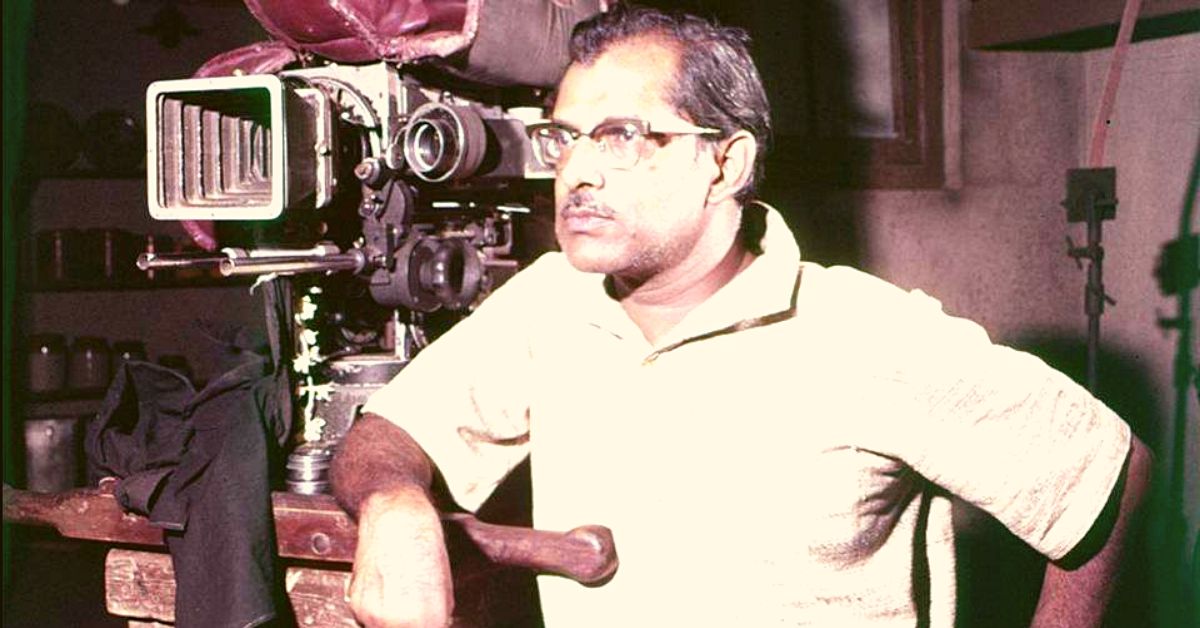An Ode to Hrishikesh Mukherjee, The Legend Who Crafted ‘Anand’ & ‘Golmaal’
An all-time great of Indian cinema, Hrishi da knew how to tell the simplest of stories in the most enchanting manner. But what made his work resonate deeply with both critics and audiences was the fact that he would bring ordinary Indians to life on the silver screen. #Tribute #DeathAnniversary #IndianCinema

Babumoshai . . . zindagi lambi nahi badi honi chahiye,
said Anand Sehgal, a terminally-ill cancer patient to his friend, Dr Bhaskar Banerjee.
The quote roughly translates to “Life is not about how long you live; it is about how well you live it”. This dialogue, immortalised by Rajesh Khanna who played the namesake in the 1971 classic-Anand, sums up the life of its legendary director Hrishikesh Mukherjee.
It’s a moment in the film which evokes an amalgam of pathos and hope.
Give an elegant makeover to your outfits with this organic cotton stole! Click here to add some khadi to your wardrobe and support our traditional artisans.
Life, after all, is about living through different moments and experiencing them to the fullest. Is it any surprise that for the film, Mukherjee took inspiration from his own life? Mukherjee’s bond with actor Raj Kapoor, who was ill at the time, inspired the relationship between Anand and Dr Bhaskar (played by Amitabh Bachchan).
Kapoor would call Mukherjee ‘Babumoshai’ as Anand calls Dr Bhaskar in the film. Anand Sehgal, meanwhile, is a Punjabi, just like Raj Kapoor.
The story of Anand, in many ways, was inspired by Mukherjee’s fear of losing Raj Kapoor. Mukherjee crafted his movies using the mould of life. This is the reason why he directed some of the best and most memorable Hindi movies of yore.
Born on 30 September 1922, in pre-Independence Kolkata, he traversed the path of an ordinary middle class Indian; studying science, graduating with a BSc in chemistry wanting to become a biochemist, and eventually teaching. However, he soon caught the art bug and worked at an editing lab before taking on the role of a cameraman and editor in New Theatre, a Kolkata-based film studio, where he mastered the art of film editing.
Following his stint there, he would work with acclaimed filmmaker Bimal Roy in Mumbai as his film editor in landmark films like ‘Do Bigha Zamin’ and ‘Devadas’. Mukherjee was an editor par excellence who could salvage films out of the depths of despair. Under the mentorship of Roy, he learnt all aspects of filmmaker and even wrote the script for ‘Do Bigha Zameen’, which was inspired by the Italian classic ‘Bicycle Thieves’.
But it was the iconic actor Dilip Kumar, who Mukherjee credited for making him into a filmmaker. Kumar worked for free in Mukherjee’s first film Musafir (‘traveller’), which deals with the cycle of life of the three families living in the same house.

Most of the 40-plus films Mukherjee made in his storied career articulated the human condition. There was nothing extravagant, ostentatious or experimental in form, themes or treatment he adopted, but his work resonated deeply with both critics and audiences alike because of “their middle-of-the-road accessibility, heart-warming irony and literate sensibilities,” writes film historian Dinesh Raheja for Rediff.
Add to these sensibilities, his films have a fantastic sense of humour about them as well like Golmaal and Chupke Chupke, and it was not of the kitschy slapstick variety.
Many critics often state how his ‘middle-of-the-road’ films like Anuradha catered to the educated middle class of the time. The film explores how Anuradha Roy (played by Leela Naidu) grapples with the choice of living with her husband Dr Nirmal Chowdhary (Balraj Sahni), an idealistic doctor serving the poor in a village, and her passion, which is music. However, that’s a lazy understanding of Mukherjee’s work. His films cut through that divide.
There is Satyakam (1969) starring Dharmendra, Sharmila Tagore, Sanjeev Kumar, and Ashok Kumar, which focuses on a young man’s disillusionment with what Independence has brought to India. Did freedom from the British mean replacing foreign oppressors with local ones? Then there is also Namak Haraam, which once again stars Rajesh Khanna and Amitabh Bachchan. Vicky (Amitabh Bachchan) is torn between his friendship with Somu (Rajesh Khanna), a blue-collared worker in a factory, and fulfilling his capitalistic dreams.
His characters spoke the same language, faced similar issues, and their heartache and happiness found an echo in your own. If Bawarchi was about a large dysfunctional Indian family that needs a little push to realise there’s love beneath all that friction, Khoobsurat pitted the young against the old but underlined that every generation has its strengths and weaknesses. But mostly, his cinema was about the primacy of human relationships, writes film critic Jyoti Sharma Bawa.
Many of his classics reflect this assessment as well—Khubsoorat (1980), Naram Garam (1981), Anupama (1966), Guddi (1971), and Milli (1975)—amongst many more. Besides introducing stars like Rajesh Khanna, Amitabh Bachchan and Jaya Bachchan to mass audiences, he also brought home their own lives and struggles.
Mukherjee would go onto win the Dadasaheb Phalke Award by the Government of India, in 1999 and the Padma Vibhushan for his contributions to Indian cinema. He passed away on August 27, 2007, in Mumbai as a consequence of renal failure.
“Standing on your balcony, one can look down and see the dirty drains or can look up and see the beautiful sky and stars,” Mukherjee once said in an interview.
In many ways, these words articulate the human condition which navigates through moments of beauty and darkness. He brought this facet onto his cinema and thus brought colour to our own everyday lives.
Also Read: India’s 1st Superstar: Why Rajesh Khanna’s ‘Guru Kurta’ Remains in Vogue!
(Edited by Saiqua Sultan)
Like this story? Or have something to share? Write to us: [email protected], or connect with us on Facebook and Twitter.

Similar Story

National Film Awards: 10 Real-Life Facts About Suriya’s Role in Soorarai Pottru
Strap: National Awards 2022: Soorarai Pottru has won Best Feature Film award and actor Suriya has won the Best Actor award. The movie is based on the true story of Captain GR Gopinath, founder of the Air Deccan airline.
Read more >
If you found our stories insightful, informative, or even just enjoyable, we invite you to consider making a voluntary payment to support the work we do at The Better India. Your contribution helps us continue producing quality content that educates, inspires, and drives positive change.
Choose one of the payment options below for your contribution-
By paying for the stories you value, you directly contribute to sustaining our efforts focused on making a difference in the world. Together, let's ensure that impactful stories continue to be told and shared, enriching lives and communities alike.
Thank you for your support. Here are some frequently asked questions you might find helpful to know why you are contributing?


This story made me
-
97
-
121
-
89
-
167












